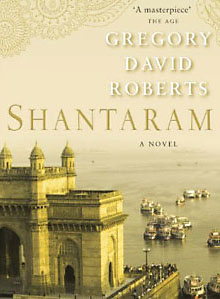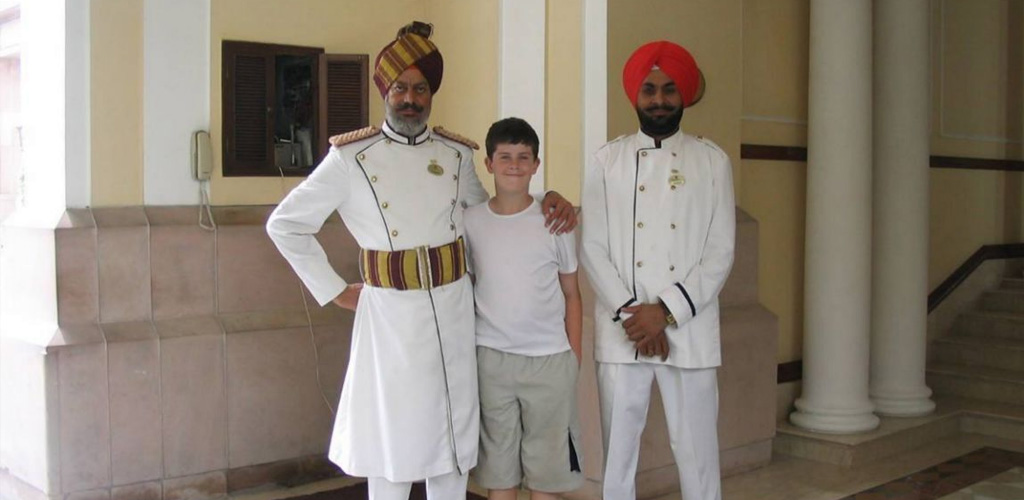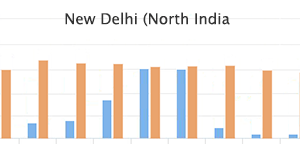India Travel Notes
Planning a trip to India can be daunting. Which is why we are here. About 60 – 90 days before your departure date, we'll send you a detailed pre-tour packet of printed materials, containing everything you need to know, right down to our recommendations on books to take with you.
Despite the challenges you may have heard or read about the region, we are here to ensure your India vacation goes not only smoothly, but is one of the most remarkable you've ever had. For us, your trip preparation begins well before you depart with careful planning and arrangements.
We've posted some of the most basic information here so you can get an early start. This page does not pertain to be comprehensive; it's just a starting point to make India feel more manageable and accessible. Please don't hesitate to contact us with any questions you may have. We are also happy to place you in contact with our past travelers for their advice.
INDIA CLIMATE
![]() Best Months : Mid-October through February (North)
Best Months : Mid-October through February (North)
![]() Moderate : March to June
Moderate : March to June
![]() Rainy : Mid-July through September
Rainy : Mid-July through September
[View India Weather & Climate Chart]
BOOK TO PACK
 Maximum City
Maximum City
Read this if you are going to Mumbai or the more current and wildly popular Behind the Beautiful Forevers: Life, Death, and Hope in a Mumbai Undercity, by Katherine Boo. Arguably, the finest class novels on India are E.M. Forster's novel Passage to India, Salman Rushdie's Midnight Children, and A Fine Balance by Rohinton Mistry, but for something more contemporary try the popular potboiler Shantaram by Gregory David Roberts.
Climate and When to Go
Nowhere on the planet can rival India for climatic variation. You can travel from freezing Himalayan mountains to humid jungle, dusty desert and monsoon-battered coastline. With such diversity, there is no single time of year that's perfect for everywhere. However, the cooler months of November to March are good for most of the country and anywhere on a classic Indian itinerary. If your time of year is set to other months, then we know a variety of destinations that will be coming into their peak months.
Pre-Departure Planning
Passport
Passport
Your passport must be valid for six months beyond the date of your arrival in India; please check your passport is indeed valid for this amount of time.
Visa Requirements
Citizens of almost all nations must obtain documentation in advance of traveling to India. This ETA is not a laborious process but is absolutely essential for travel. Among other nationalities, it applies to all citizens of the US, Canada, UK and EU countries.
Obtaining a Visa
Indochina Travel will assist in obtaining your Indian visa for you. You must have a valid passport and there should be two full blank pages in your passport.
Before your departure, an Electronic Travel Authorization (ETA) will be printed and mailed to you. This document should be carried with your passport and produced to the immigration officer upon your arrival in India. Please note it is now mandatory for all incoming tourists to be mandatory biometrically scanned.
What to Pack and Wear
Though it is not mandatory to wear modest clothes at all times, revealing clothing is frowned upon. Apart from anything else, it's likely to attract a lot of unwanted attention.
You should wear clothes that are modest and comfortable. Cotton is advised as it's lightweight and flexible; you'll encounter thousands of places to purchase cotton trousers and shirts when in the country. Cities like Jaipur, New Delhi and Agra are cosmopolitan in nature and people dress more adventurously, particularly in the new parts of the city.
We advise not to wear open-toe shoes or sandals as sidewalks and other surfaces provide hazards to feet, not to mention they can be very dirty and dusty.
Landing in India
Money Matters
The Indian currency is the rupee. Dollars may be changed into rupees at ubiquitous moneychangers and hotels.
For convenience, plan to bring enough currency to exchange for your personal expenses. It's recommend to bring mint-condition, high-denomination bills. While Visa and MasterCard are widely accepted in mid-to large-size cities, ATM machines are unreliable and may not accept your bank's card, especially in rural areas. It's well worth stocking up on local currency before traveling into rural areas – your guide can advise.
Note that travelers cheques are not accepted in India.
Bargaining
Bargaining is customary in India. It can feel like a challenge and it can be overwhelming at times. Seemingly, in India, every transaction is negotiated, from shop items, meal checks, transport, and everything else. As a general rule, start low and don't pay more than half the initial asking price of items. Try for 70% off and don't accept a purchase if the discount is less than 30% the original price. Sometimes it's possible to pay much less, especially if you buy more than one item. If you feel uncomfortable, ask you guide to make a purchase for you or visit fixed-price stores which display prices.
Tipping
India is a tipping culture. Tipping for almost everything is required to keep things running smoothly. As a rough guide, tipping is typically at these rates:
Upscale restaurants: 5%
Hotel restaurants: 10%
Porters: 10-15 rupees per bag or service
Drivers: 1,200 rupees per day, per group
Wi-Fi and Internet
Wi-Fi Internet is not common in public areas. All hotels you are likely to stay at offer Wi-Fi and some charge for this access. Expect spotty and unreliable connection in more rural areas.
Phone Coverage
It's recommended to obtain a local sim card when in India. Your guide will assist and we can also obtain a sim card in advance, presenting it to you when you arrive.
Verizon, Sprint, and T-Mobile offer roaming coverage in India with ever falling roaming charges. Traveling within city limits AirTel is a better choice. Reliance, is a national level network and gives you broader connectivity. MTNL/BSNL, the national carrier, also has a good overall reach though connectivity is sometimes an issue. Vodafone is a good network for city travels, but its reach is limited to only a few states.
Electrical
Most hotels in India typically use European dual round-prong outlets. Adapters are available at the hotel, though you may want to purchase a universal one for your travel. India's electric current is 220 volts, unlike North America 110 volts, although your electrical items should be able to adapt.
Traveling in India
Air and Train Travel Arrangements
Traveling around India is a delight. A rapidly growing flight network enables expedited travel between major tourist destinations, while the train journeys are an iconic part of the local experience. Destinations that you will be traveling to, typically New Delhi, Agra, and Jaipur, have roads in good to excellent condition. However, legendary traffic means we will attempt to avoid overland transfers at times and use airlines.
All ticketing for domestic travel in India is arranged by Indochina Travel. Your flight and rail itineraries are provided before departure, while your individual tickets will be given to you in person after your arrival in country, along with a flight record form. Please note this form is mandatory before you are admitted inside any airport and must be shown upon entry into the terminal. In India, you are required to check-in a minimum of 45 minutes prior to take-off, failing which you will not be allowed on board.
Luggage
All domestic carriers in India have a limit of 33 pounds (15 kilos) for check-in baggage and 15 pounds (7 kilos) for cabin baggage. Airlines allow only one piece of cabin baggage. It is recommended that you carry your camera and other expensive electrical itemst in your cabin baggage. Heavy equipment such as tripod, spare batteries should always be tucked in your check-in baggage.
Health and Medical
Specific vaccinations are not required for travel to India. However, they are widely recommended by the majority of health professionals. From the outset, review your immunization record to make sure you are up to date on the standard vaccines and booster shots. These typically includes immunizations for measles mumps and rubella (MMR), diphtheria, and polio. You may need to receive tetanus booster shot. And it's important to make sure that your flu shot is current.
Consult your medical professional for detailed advice on specific vaccines. In most cases, the following will be recommended as a minimum for safe travel to India: Hepatitis A, Hepatitis B, Typhoid, Japanese Encephalitis.


